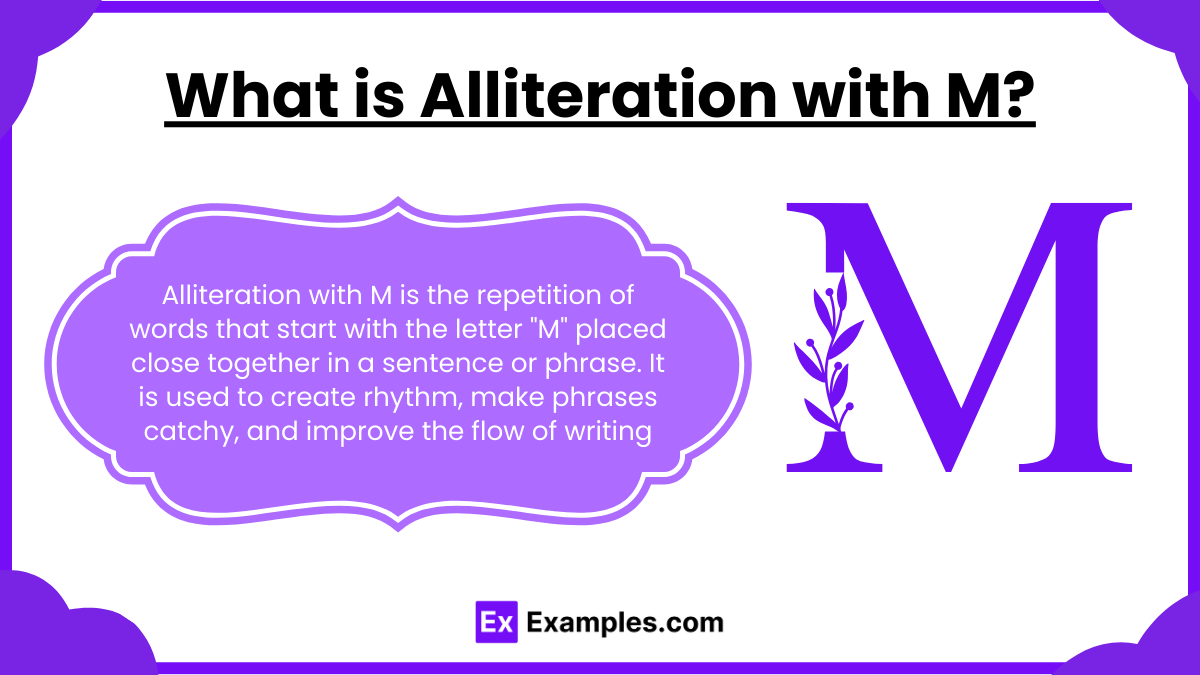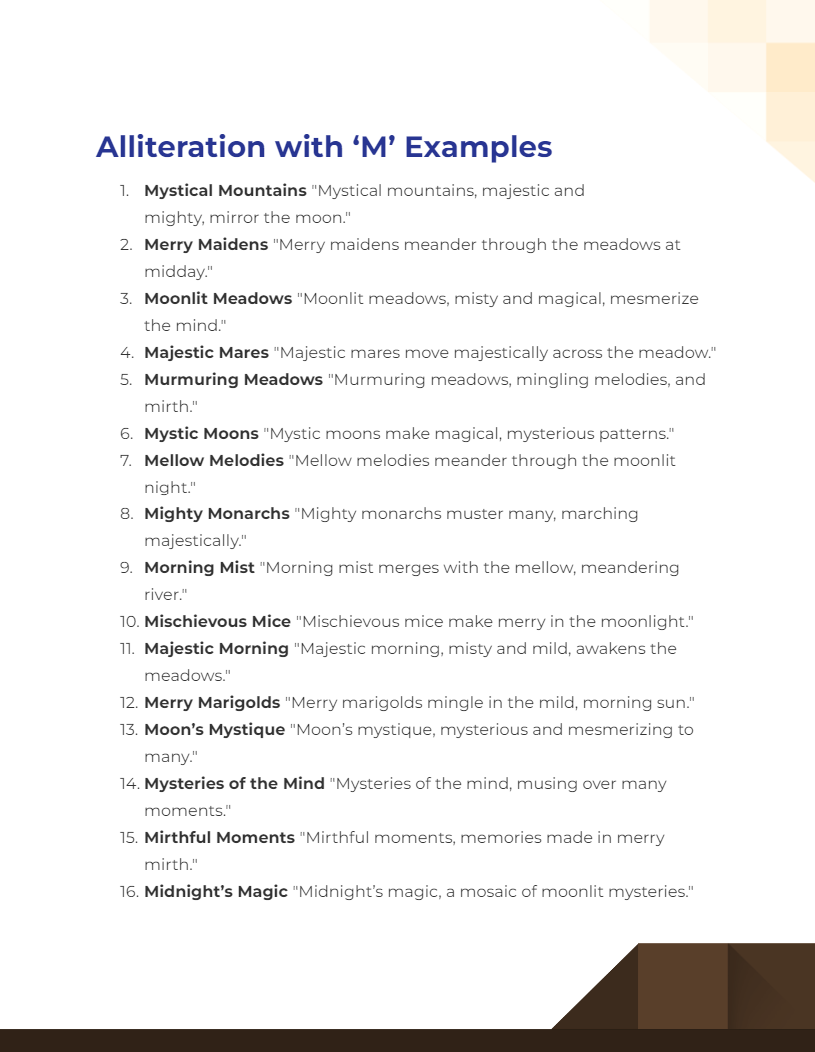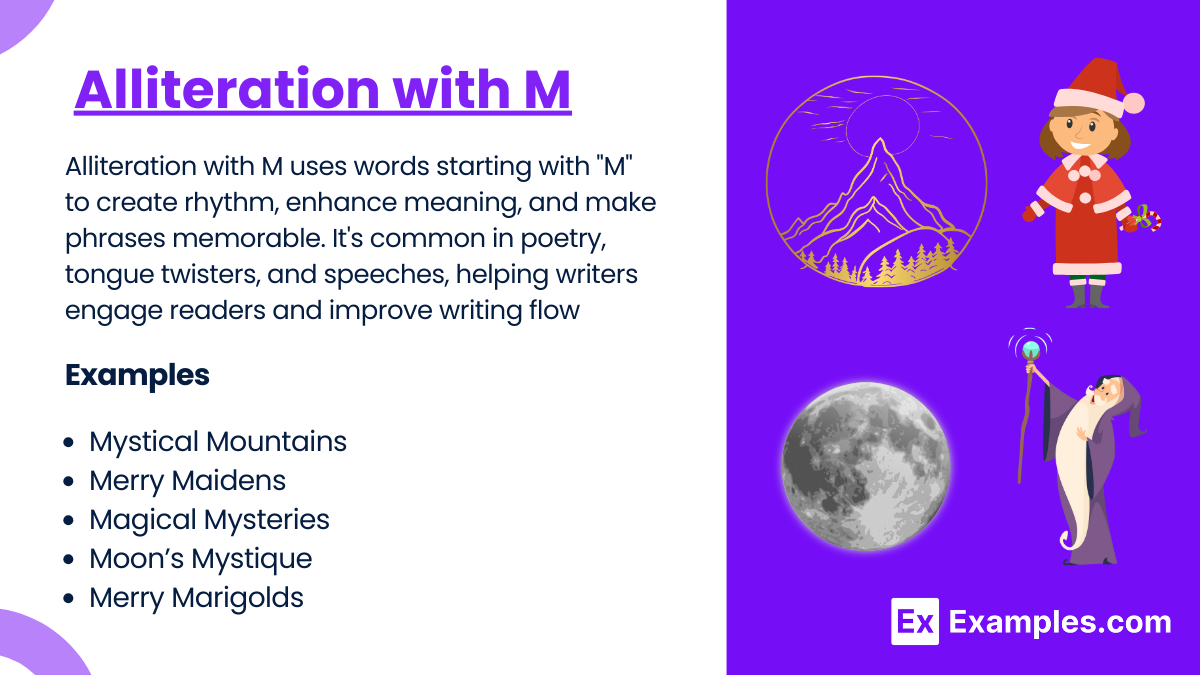19+ Alliteration with M Examples
Alliteration with M is a popular literary device where words starting with the letter “M” are used closely together to create rhythm, enhance meaning, and make phrases more memorable. This technique is common in poetry, tongue twisters, and alliterative literature, helping writers engage readers with a pleasing sound pattern. Using alliteration not only improves writing flow but also emphasizes key points, making content more impactful. Whether for creative writing or speeches, mastering alliteration with M adds charm and clarity to your words.
Download Alliteration with 'M' Examples
Download Alliteration with 'A' to 'Z' Examples
What is Alliteration with M?

20 Alliteration with ‘M’ Examples

Download Alliteration with 'M' Examples in PDF
Alliteration with the letter ‘M’ melds together a melodic and sometimes mystical quality, making language more memorable and mesmerizing. The ‘M’ sound, with its mellow and murmuring characteristics, is perfect for crafting both easy and hard alliteration examples. Particularly effective in alliteration in rhymes, the ‘M’ sound adds a rhythmic and enchanting quality to phrases. Here are 20 unique examples of alliteration with ‘M’, each accompanied by a rhyme title that captures the essence of the phrase.
- Mystical Mountains “Mystical mountains, majestic and mighty, mirror the moon.”
- Merry Maidens “Merry maidens meander through the meadows at midday.”
- Moonlit Meadows “Moonlit meadows, misty and magical, mesmerize the mind.”
- Majestic Mares “Majestic mares move majestically across the meadow.”
- Murmuring Meadows “Murmuring meadows, mingling melodies, and mirth.”
- Mystic Moons “Mystic moons make magical, mysterious patterns.”
- Mellow Melodies “Mellow melodies meander through the moonlit night.”
- Mighty Monarchs “Mighty monarchs muster many, marching majestically.”
- Morning Mist “Morning mist merges with the mellow, meandering river.”
- Mischievous Mice “Mischievous mice make merry in the moonlight.”
- Majestic Morning “Majestic morning, misty and mild, awakens the meadows.”
- Merry Marigolds “Merry marigolds mingle in the mild, morning sun.”
- Moon’s Mystique “Moon’s mystique, mysterious and mesmerizing to many.”
- Mysteries of the Mind “Mysteries of the mind, musing over many moments.”
- Mirthful Moments “Mirthful moments, memories made in merry mirth.”
- Midnight’s Magic “Midnight’s magic, a mosaic of moonlit mysteries.”
- Meadows of Mirth “Meadows of mirth, brimming with merry, mirthful music.”
- Myriad of Memories “Myriad of memories, melding into a mystic mosaic.”
- Magical Mysteries “Magical mysteries, masked in the moon’s majesty.”
- Majestic March “Majestic march, many miles through the misty meadows.”
Alliteration Sentence Examples with ‘M’
Alliteration sentence examples with ‘M’ often exude a melodious and mesmerizing quality, using the soft ‘M’ sound to create a smooth and flowing rhythm. Such alliteration is frequently used in various forms of literary and artistic expressions, including alliteration in poems, songs, and movies, adding a lyrical or dramatic touch. Here are three examples:
- “Maggie’s magical melodies mesmerized the merry crowd.”
- “Miles of misty mountains merged with the morning sky.”
- “Martha’s marvelous marigold garden mirrored the morning sun.”
Alliteration Examples with ‘M’ Words
Alliteration examples using ‘M’ words demonstrate the impact of this consonant in creating rhythmic, engaging phrases. This form of alliteration is often used for its poetic quality in alliteration in songs. Here are three examples:
- “Majestic maples masked the meandering mountain path.”
- “Melancholy music meandered through the moonlit mansion.”
- “Mystified, Martin maneuvered through the maze-like market.”
Alliteration Examples with ‘M’ Sound
The ‘M’ sound in alliteration can produce a variety of effects, from gentle and soothing to vivid and lively. These examples show how the ‘M’ sound can be employed in alliterative structures to create engaging and rhythmic sentences. Here are three examples:
- “Moonlight mirrored in the motionless, misty lake.”
- “Muffled murmurs of the morning market meandered in the air.”
- “Mysterious masks made the masquerade magically memorable.”
Alliteration Examples with ‘M’ Name
Incorporating names that start with ‘M’ in alliteration adds a personal and often endearing touch to the phrases, enhancing their relatability and impact. Here are three examples:
- “Molly’s miniature model cars made magnificent masterpieces.”
- “Michael’s meticulous method made math manageable.”
- “Mandy’s mountainous muffins mesmerized many mouths.”
Alliteration Poem with ‘M’
An alliteration poem with ‘M’ uses the repetitive ‘M’ sound to create a rhythmic and engaging poetic experience. Alliteration in poems, especially with the ‘M’ sound, adds a unique lyrical quality. Here are three examples:
- “Misty mornings, meadows’ murmur, / Moon’s mystique, night’s slumber.”
- “Meadows meet the moonlit sky, / Melodies of night’s lullaby.”
- “Mighty mountains, mist’s embrace, / Moonbeams dance in silvery lace.”
Alliteration Beginning with ‘M’
Alliteration beginning with ‘M’ sets a specific tone and rhythm in a phrase, often creating a memorable and aesthetically pleasing effect. This type of alliteration can be found in various artistic expressions, including alliteration in movies, where it adds a harmonious element. Here are three examples:
- “Majestic mares galloped across the meadows at midnight.”
- “Marvin’s machine meticulously mapped the mysterious maze.”
- “Miranda’s melodic voice made the moonlit evening magical.”
Alliteration with M Examples for Kids
Alliteration with M is when words starting with the letter “M” are used together in a sentence to make it fun and easy to remember. It helps kids improve their reading and speaking skills while enjoying playful sounds.
- Molly made magical muffins.
- Max’s monkey makes music.
- Milly met many merry mice.
- Mike munches on messy marshmallows.
- Mommy mixed my milkshake.
- Misty mountains meet morning mist.
- Mark’s mom makes marvelous meals.
- Many mice marched merrily.
- Mary’s miniature moose moves.
- Meg made my morning marvelous.
Alliteration with M Examples for Students
Alliteration with M is the repetition of words starting with the letter “M” used closely together in a sentence to create rhythm and make phrases memorable. It helps students improve their writing, speaking, and creative thinking skills.
- Mark mastered math with motivation.
- Many meaningful memories made Monday magical.
- Maria mentioned meeting her music mentor.
- Mike managed multiple missions marvelously.
- Morning meetings make minds more mindful.
- Megan’s magical map marked mysterious mountains.
- Max moves mountains with mere motivation.
- My math mentor made mistakes manageable.
- Misty mornings make me miss my mom.
- Many minds merged to make marvelous music.
Alliteration with M Examples to Describe Someone
Alliteration with M is a fun way to describe someone using words that start with the letter “M.” It helps make descriptions catchy, memorable, and engaging.
- Maria is a marvelous, motivated mentor.
- Max is a mighty, mindful man.
- Molly is a merry, magical musician.
- Mark is a modest, methodical mathematician.
- Megan is a magnificent, meticulous manager.
- Mike is a mysterious, magnetic mastermind.
- Mia is a mature, mindful mediator.
- Matthew is a mild, meaningful motivator.
- Michelle is a memorable, masterful maker.
- Mason is a modern, methodical mechanic.
How to Write Alliteration with ‘M’?
Creating alliteration with the letter ‘M’ involves crafting phrases or sentences where the ‘M’ sound is repeated at the beginning of closely connected words. The ‘M’ sound, known for its mellow and melodious quality, can add rhythm and a soothing tone to your writing. This technique is used across various contexts, including alliteration in figurative language exercises and in educational materials, such as alliteration for first grade. Here’s a step-by-step guide to creating effective alliteration with ‘M’:
- Identify the ‘M’ Sound: Start by familiarizing yourself with the ‘M’ sound, which is soft and resonant. It’s a versatile sound that can be used in a variety of contexts.
- Select a Theme: Choose a theme or subject for your sentence. This will help you find relevant ‘M’ words that fit your topic, whether you’re creating alliteration with answers or just for fun.
- Brainstorm ‘M’ Words: Make a list of words starting with ‘M’. Try to include a mix of nouns, verbs, and adjectives to add depth to your alliteration.
- Formulate Your Phrase or Sentence: Arrange the ‘M’ words to form a sentence or phrase. Aim for a natural flow that emphasizes the alliterative effect.
- Read Aloud for Rhythm: Alliteration’s effectiveness is often best judged audibly. Read your sentence aloud to ensure it has a pleasing rhythm.
- Revise for Clarity and Impact: Make sure your alliterative phrase is clear and contributes effectively to your overall message or story.
- Apply in Various Contexts: Whether you’re using it in alliteration figurative language exercises, as part of teaching alliteration for first grade, or in creative writing, adapt your use of ‘M’ alliteration to suit the purpose and audience.
Tips for Using Alliteration with ‘M’
Here are Tips for Using Alliteration with ‘M’:
- Use Sparingly: Overuse of alliteration can overshadow the main message. Use it to emphasize key points or add stylistic flair but in moderation.
- Maintain Clarity: Ensure your sentence is clear and understandable. The alliteration should not confuse the reader.
- Vary Word Length and Complexity: Mix short and long ‘M’ words, as well as simple and complex ones, for a more interesting textual rhythm. This is especially important in alliteration for first grade, where simpler language is necessary.
- Consider the Mood: The ‘M’ sound is often soothing and gentle. Use it in contexts where this mood is desired.
- Read and Revise: Reading your work aloud helps you assess the rhythm and flow. Make adjustments to ensure the alliteration enhances the text.
- Appropriate for Audience: Tailor your alliteration to your audience. For example, alliteration for first grade should be simpler and more playful than alliteration for adults.
- Explore Different Forms: Try ‘M’ alliteration in various forms of writing, from poetry and stories to advertising and academic work, to understand its effect.
Remember, the key to effective alliteration with ‘M’ is balancing creativity with readability, ensuring that the alliterative phrases enhance rather than detract from your writing.
FAQs
What are the Good Alliteration with ‘M’?
Good alliteration with ‘M’ involves phrases or sentences where the ‘M’ sound is repeated in a way that is engaging and pleasing to the ear. These alliterations are characterized by their smooth, melodic quality, which can be both soothing and captivating. Good ‘M’ alliterations are often used as famous alliteration examples in various literary contexts. Examples include:
“Misty mornings make meadows magically mesmerizing.”
“Muffled murmurs of the moonlit sea merge with the midnight melody.”
“Marbled mosaics in the museum mesmerized the many visitors.”
These examples show the range of effects that can be achieved with ‘M’ alliterations, from creating serene imagery to evoking a sense of wonder.
What is the Effect of ‘M’ Letter in Alliteration?
The effect of the ‘M’ letter in alliteration is to create a smooth, mellow sound that adds a lyrical and often soothing quality to the text. The ‘M’ sound is gentle and can be used to convey a sense of calmness, tranquility, or introspection. In literature, ‘M’ alliteration is often used for its musical quality, enhancing the auditory experience of a piece. This effect is prominent in great alliteration examples across various forms of literature, including alliteration in poems, songs, and prose. The ‘M’ sound is versatile and can be effectively used in alliteration for kids, students, and adults, depending on the context and the words chosen.
What is the Alliteration ‘M’ Type of?
Alliteration with the letter ‘M’ is a type of consonantal alliteration, where the consonant sound at the beginning of adjacent or closely connected words is repeated. Despite being a consonant, the ‘M’ sound often has a softer and more melodic quality compared to other consonants. This type of alliteration is popular in various forms of writing, from creative poetry to effective prose. It’s a favorite in educational materials for its appeal and effectiveness, widely used in alliteration for students and alliteration for kids. The ‘M’ type of alliteration can create different effects, from whimsical and light (common in alliteration for kids) to more profound and impactful (often used in alliteration for adults and students), depending on the context and the chosen words.


